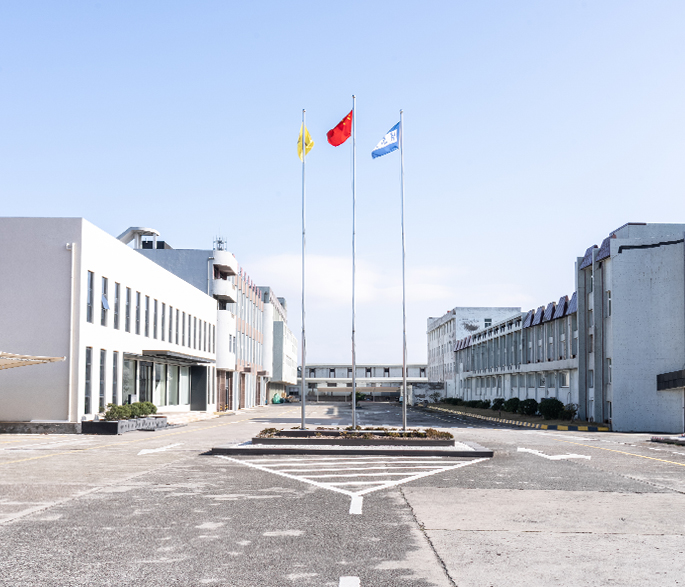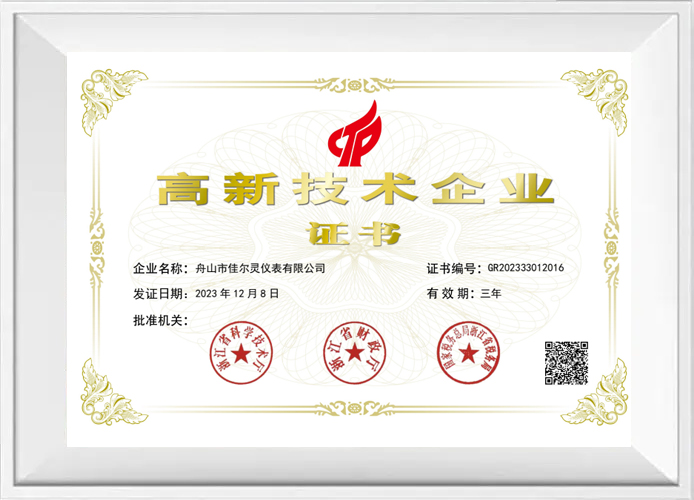Need help? Call us: +86-15105800333 / Whatsapp:+86-15105800333 / Email:[email protected]
- Home
- Product
- About
- Strength
- News
- Contact

Zhoushan Jiaerling Meter Co., Ltd. was established in 2004. It is China General Pressure Gauge Manufacturers and Custom General Pressure Gauge Suppliers, which is a high-tech enterprise integrating design, research and development, manufacturing, import and export trade.
The company is located in Zhoushan City, Zhejiang Province, covering an area of 15,000 square meters, equipped with a 100,000-level clean workshop, conventional production and assembly workshop, automated production workshop, new laboratory and comprehensive office building.
After more than 20 years of hard work and development, the company has a stable design and development, production team, and advanced production and testing equipment. The company specializes in the production of various types of pressure gauges with complete specifications, and the annual output of pressure gauges reaches 6 million. In order to further develop, the company not only seeks improvement in technology, but also pays more attention to product quality and after-sales service. The company's purpose is to "regard quality as life, survive by reputation, promote development by technology, and serve customers with high-quality brands". The products are sold all over the world and are well received by domestic and foreign customers.
In 2019, the company participated in the compilation of the standard T/CECS10012-2019 "Gas Heating Hot Water Boiler and Water Heater Water Circuit Components" of the China Engineering Construction Standardization Association.
Under the implementation of modern and digital enterprise management, the company has successfully introduced the advanced MES system in 2023, and the order process is fully visualized to track data, ensuring the continuity of production and improving production efficiency.
The company will continue to adhere to the principles of excellence, accuracy, reliability, continuous improvement, and meeting customer needs, hoping to share harmony and prosperity with friends across the country.








In the complex fluid measurements of the petroleum and chemical industries, the accuracy and stabili...
View MoreIn the rigorous environment of the petrochemical industry, the reliability of pressure measuring ins...
View MorePP diaphragm pressure gauges, with their polypropylene (PP) body and corrosion-resistant diaphragm m...
View MoreThe core function of a PP diaphragm pressure gauge, particularly one used in corrosive environments ...
View MoreFour Direct Impacts of an Inaccurate Brewing Pressure Gauge A brew pressure gauge displays the actua...
View MoreElastic sensitive elements are the core components of general pressure gauges, which are responsible for converting the pressure of fluid or gas into mechanical displacement. In JRL general pressure gauges, common elastic sensitive elements include Bourdon tubes and diaphragms. Bourdon tubes are curved tubes with elliptical cross-sections and fixed open ends. When subjected to pressure, the free end will be displaced. This displacement is amplified and transmitted to the indicating mechanism through the transmission mechanism. The diaphragm is made of thin metal sheets and has a circular or elliptical structure. When subjected to pressure, the deformation of the diaphragm directly drives the pointer to rotate. When selecting elastic sensitive elements, JRL strictly follows international standards to ensure that they have excellent sensitivity and stability to meet various application requirements.
The transmission mechanism, as an important bridge connecting the elastic sensitive element and the indicating mechanism, is responsible for amplifying and transmitting tiny displacements to the indicating mechanism. In JRL general pressure gauges, the transmission mechanism is usually composed of components such as connecting rods and gears. When the elastic sensitive element is displaced due to pressure, the displacement is transmitted to the gear through the connecting rod. The rotation of the gear further amplifies the displacement, and finally drives the pointer to move on the dial. When designing and manufacturing the transmission mechanism, JRL pays attention to the compactness of the structure and the accuracy of the transmission to ensure the reliability and consistency of the measurement results.
The indicating mechanism is the output part of the universal pressure gauge, which is responsible for converting the displacement transmitted by the transmission mechanism into an intuitive pressure value display. In the JRL universal pressure gauge, the indicating mechanism is mainly composed of a pointer and a dial. The pointer is connected to the elastic sensitive element through the transmission mechanism. When the elastic sensitive element is subjected to pressure, the pointer will rotate on the dial to accurately indicate the current pressure value. When selecting the material of the pointer and the dial, JRL pays attention to the fineness of the process to ensure the clarity and accuracy of the display, thereby enhancing the user's measurement experience.
As a protective component of the universal pressure gauge, the housing is responsible for protecting the internal elastic sensitive element, transmission mechanism and indicating mechanism to prevent interference and damage from the external environment. In the JRL universal pressure gauge, the housing is usually made of metal or plastic, with good sealing and corrosion resistance. In addition, the housing is provided with mounting holes and connection interfaces, which facilitates users to install the pressure gauge on the equipment or connect it with other instruments. When designing and manufacturing the housing, JRL pays attention to the firmness and aesthetics of its structure to ensure the durability and market competitiveness of the product.
Before installing the general pressure gauge, adequate preparation is the key to ensure measurement accuracy and equipment stability. First, the user needs to confirm whether the model and specifications of the selected pressure gauge meet the actual application requirements. JRL provides pressure gauges of various models and specifications. Users should comprehensively consider the characteristics of the measured medium (such as corrosiveness, high temperature, high pressure, etc.), measurement accuracy requirements, and installation environment to ensure that the most suitable product is selected. Secondly, carefully check the appearance and internal structure of the pressure gauge to ensure that it is not damaged or defective to ensure the reliability of the equipment. Finally, prepare the necessary installation tools and materials, including screwdrivers, wrenches, sealing washers, etc., to facilitate the smooth completion of the installation process.
Selecting the pressure tapping position of the pressure gauge is a key step in the installation process. The correct pressure tapping position can significantly improve the accuracy of pressure measurement. When selecting the pressure tapping, several important principles should be followed. First, avoid selecting the eddy current area. The pressure tapping should be located in the area where the flow beam of the measured material is stable, and avoid being located in the bend, bifurcation or eddy current formation area of the pipeline. Secondly, when handling turbid materials with dust, solid particles or sediment, the source component should be installed tilted upward, and on horizontal pipes, it should be installed at an acute angle to the material flow. In addition, if the pressure tap is set near the regulating valve, the distance from the valve should be noted: if the pressure tap is in front of the valve, the distance should be no less than two pipe diameters; if it is behind the valve, the distance should be at least three pipe diameters. JRL's professional technical team can provide detailed suggestions for selecting the pressure tap location to ensure high accuracy of the measurement results.
Installing the pressure source component is another important part of ensuring the normal operation of the pressure gauge. In this process, users need to pay attention to several key points. First, the source components on the equipment should be installed simultaneously with the equipment manufacturing, while the source components on the pipeline should be installed together during the prefabrication and installation of the pipeline. Secondly, the opening and welding of the source component must be completed before the anti-corrosion, lining and pressure test of the equipment or pipeline. In high-pressure environments, especially for the opening of alloy steel and non-ferrous metal equipment and pipelines, it is recommended to use mechanical processing methods to ensure safety and reliability. At the same time, when installing the source components, avoid drilling or welding on the welds and edges of the equipment or pipelines, and avoid using ferrule joints for connection to reduce the risk of leakage. With rich practical experience and expertise, JRL's pressure gauge installation team can ensure the correct installation of pressure source components and guarantee the user's measurement accuracy.
When installing the pressure gauge body, users need to pay special attention to several important matters. First, the pressure gauge should be installed perpendicular to the horizontal plane to ensure that the pointer indicates the dial accurately. Secondly, the instrument should be oriented in a direction that is convenient for operation and observation so that the user can read the pressure value at any time. In addition, in the same pipeline, the pressure gauge should be set before the thermometer, and the hole spacing should be greater than or equal to 200mm to avoid mutual influence.